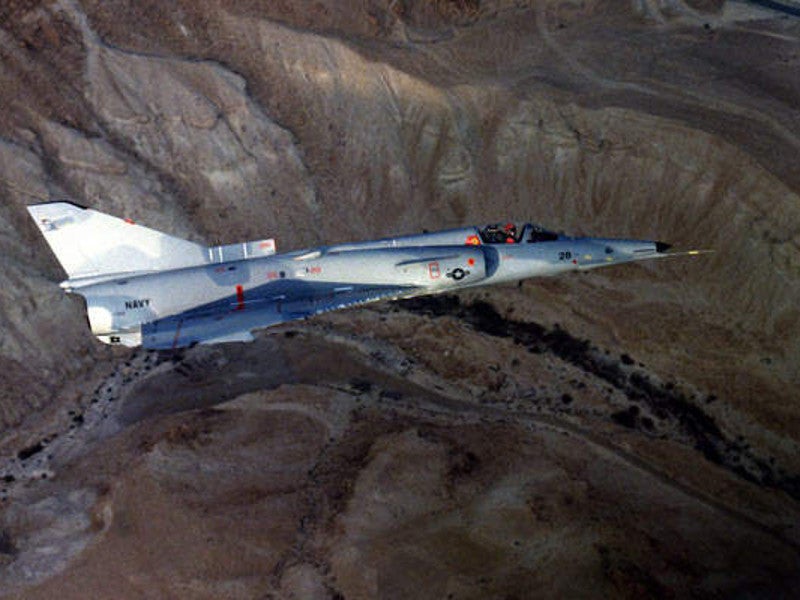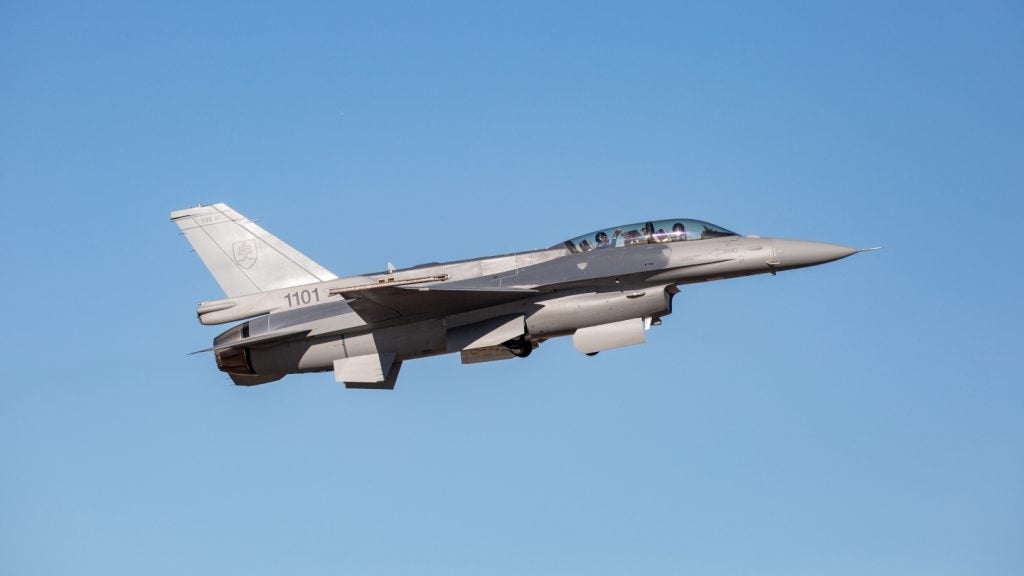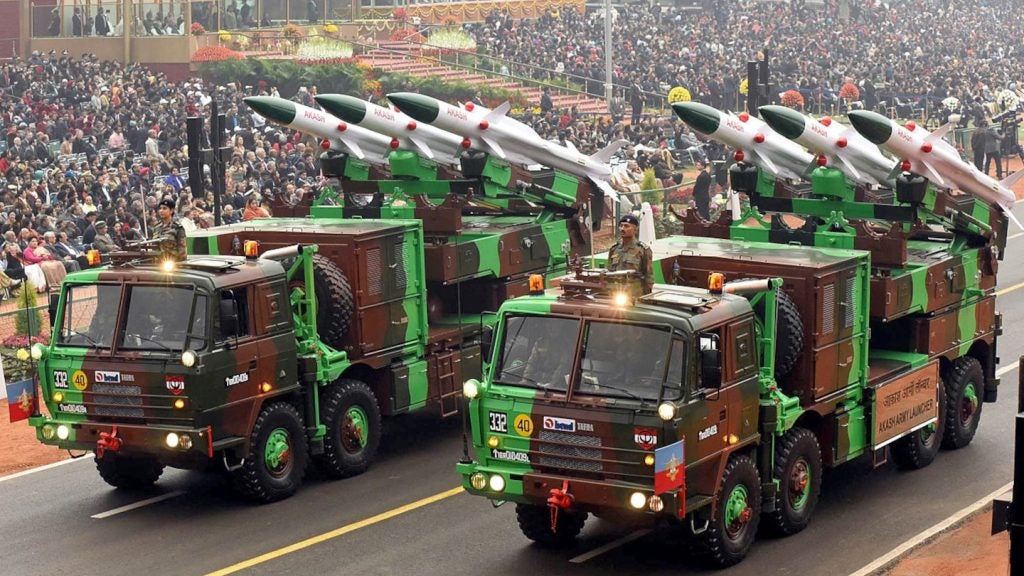The F-21 Kfir fighter jet is a single-seat multitask fighter built by Israel Aerospace Industries (IAI). The fighter craft was first built for Israeli Air Force (IAF). The first Kfir was delivered to the IAF in 1975 and entered into service in 1976.
The Kfir was sold to various countries and around 27 have been leased to the US Navy and Marine Corps.
Kfir jets are in service with air forces of Sri Lanka, Ecuador and Colombia. They are also being used as aggressor aircraft, with no weapons, by the US Navy, for providing dissimilar air combat training.
A civilian firm Airborne Tactical Advantage Company (ATAC) has been using Kfir jets to provide airborne tactical training, threat simulation and R&D to its trainers.
F-21 orders and deliveries
The Colombian Air Force awarded a multi-year contract worth $150m to IAI in late 2007 to upgrade its old jets and deliver additional jets.
The contracts included upgrading existing Colombian Air Force Kfir jets with the latest technologies as well as supplying additional jets. The Kfirs are manufactured at the Lahav division of the Military Aircraft Group in Israel.
Products manufactured by the Lahav division include avionics, combat helicopters and trainers, man-machine interface and cockpit design, aeronautical engineering tasks and assembling of weapon systems in fighter aircraft.
The IAI delivered the first batch of upgraded Kfir fighter jets to the Colombian Air Force on 22 June 2009.
F-21 Kfir mission variants
Failure of Mirage V’s power plant, the French Atar 9 engine, led to the development of Kfir jets. IAI built 100 Kfirs including the first series Kfir C1, multirole fighter Kfir C2, single-seat version Kfir C7 and double-seated TC2 Kfir models. These models began operations on 9 November 1977 during attack on Tel Azia, a terrorist training base in Lebanon, and came back with success.
The Kfir TC2 is an advanced version of Kfir C2, specifically designed as a training variant. The Kfir C2 has two tandem pairs under the fuselage and two under each wing. TC2 is a two-seater jet with a longer and lower nose to enhance the pilot’s view. Similarly, Kfir TC7 is the advanced version of Kfir C7, designed as two-seat training variant.
In addition, Kfir C10, also known as Kfir CE and Kfir 2000, varies from other fighter aircraft as it contains Elta EL/M-2032 radar, HMD capability and two 127mm×177mm multifunction displays. The Kfir TC10 designed for the Colombian Air force is an improved version of TC7, while Kfir C12 is also called as C-10 without the Elta EL/M-2032 radar.
IAI manufactured the Kfir F-21 fighter jets specifically to meet the requirements of the US Navy and the US Air Force training programmes.
The single-seat fighter jet Kfir C7 had an updated cockpit, latest avionics, inflight refuelling capabilities and smart bomb integration.
F-21 Kfir fighter jet design and cockpit
Dassult Falcon designed the Kfir by replacing Mirage V’s French Atar 9 engine with General Electric’s J79 jet engine. The J79 provides more thrust by consuming less fuel. Dassault also altered the engine configuration and enlarged the fuel intake capacity. Kfir is, thus, said to be the advanced version of Mirage V.
Kfir C2 was also developed from French Mirage V, driven with J79-J1E turbojet engine, which provides a maximum range of around 775km and travels with a maximum speed of Mach 2.3. It carries 6,085kg of disposable cargo on nine hard points.
To improve the efficiency of Mirage III aircraft, the advanced avionics situated behind the cockpit were removed to increase the fuel capacity of the aircraft while reducing maintenance costs.
F-21 Kfir weapon systems and countermeasures
Kfir jets use guns, 13,415lb (6,085kg) of mixed ordinances, 30mm cannons, missiles, bombs and rockets. It uses air-to-air missiles such as Python 3, Python 4, Python 5, Alto, Derby, and air-to-surface missiles such as Gabriel and NT-Dandy.
In addition, surface-to-surface and surface-to-air missiles such as Gil ATGM, MapatzATGM, Spike ATGM and Barak, Barak NG, Barak 8, SPYDER are also used.
An integrated electronic warfare self-protection, EL/L-8262 enables the fighter jets to defend against surface-to-air and air-to-air weapon systems.
The aircraft Kfir C7, which has two extra hard points, uses smart weapons, Elta EL/M-2021B pulse-Doppler radar, a revised cockpit with most state-of-art electronics and HOTAS (hands-on throttle and stick) controls and provision for in-flight refuelling.
F-21 Kfir fighter jet propulsion and performance
IAI initially chose two engine plants, the General Electric J79-GE-17 jet engine and the Rolls-Royce Spey turbofan for manufacturing the Kfir fighter, but later produced Kfirs with just the J79-GE-17 jet engine.
The first J79-GE-17 jet engine was manufactured by GE Aviation in New York in 1955. More than 2,500 engines are in service, and are due to continue to be so through to 2020. Kfir’s General Electric J79 engine is protected by a titanium heat shield.
Kfir can fly at an altitude of 30,000m with a maximum speed of 2,285km/h over a range of 1,300km. The advanced aircraft has the capacity to carry 7,290kg air-to-air and air-to-surface missiles, bombs and munitions on two hardpoints.
The maximum take-off weight is 14,600kg whereas combat radius and service ceiling are 768km and 18,000m.
The F-21 Kfir fighter jet is a single-seat multitask fighter built by Israel Aerospace Industries (IAI). The fighter craft was first built for Israeli Air Force (IAF). The first Kfir was delivered to the IAF in 1975 and entered into service in 1976.
The Kfir was sold to various countries and around 27 have been leased to the US Navy and Marine Corps.
Kfir jets are in service with air forces of Sri Lanka, Ecuador and Colombia. They are also being used as aggressor aircraft, with no weapons, by the US Navy, for providing dissimilar air combat training.
A civilian firm Airborne Tactical Advantage Company (ATAC) has been using Kfir jets to provide airborne tactical training, threat simulation and R&D to its trainers.
F-21 orders and deliveries
The Colombian Air Force awarded a multi-year contract worth $150m to IAI in late 2007 to upgrade its old jets and deliver additional jets.
The contracts included upgrading existing Colombian Air Force Kfir jets with the latest technologies as well as supplying additional jets. The Kfirs are manufactured at the Lahav division of the Military Aircraft Group in Israel.
Products manufactured by the Lahav division include avionics, combat helicopters and trainers, man-machine interface and cockpit design, aeronautical engineering tasks and assembling of weapon systems in fighter aircraft.
The IAI delivered the first batch of upgraded Kfir fighter jets to the Colombian Air Force on 22 June 2009.
F-21 Kfir mission variants
Failure of Mirage V’s power plant, the French Atar 9 engine, led to the development of Kfir jets. IAI built 100 Kfirs including the first series Kfir C1, multirole fighter Kfir C2, single-seat version Kfir C7 and double-seated TC2 Kfir models. These models began operations on 9 November 1977 during attack on Tel Azia, a terrorist training base in Lebanon, and came back with success.
The Kfir TC2 is an advanced version of Kfir C2, specifically designed as a training variant. The Kfir C2 has two tandem pairs under the fuselage and two under each wing. TC2 is a two-seater jet with a longer and lower nose to enhance the pilot’s view. Similarly, Kfir TC7 is the advanced version of Kfir C7, designed as two-seat training variant.
In addition, Kfir C10, also known as Kfir CE and Kfir 2000, varies from other fighter aircraft as it contains Elta EL/M-2032 radar, HMD capability and two 127mm×177mm multifunction displays. The Kfir TC10 designed for the Colombian Air force is an improved version of TC7, while Kfir C12 is also called as C-10 without the Elta EL/M-2032 radar.
IAI manufactured the Kfir F-21 fighter jets specifically to meet the requirements of the US Navy and the US Air Force training programmes.
The single-seat fighter jet Kfir C7 had an updated cockpit, latest avionics, inflight refuelling capabilities and smart bomb integration.
F-21 Kfir fighter jet design and cockpit
Dassult Falcon designed the Kfir by replacing Mirage V’s French Atar 9 engine with General Electric’s J79 jet engine. The J79 provides more thrust by consuming less fuel. Dassault also altered the engine configuration and enlarged the fuel intake capacity. Kfir is, thus, said to be the advanced version of Mirage V.
Kfir C2 was also developed from French Mirage V, driven with J79-J1E turbojet engine, which provides a maximum range of around 775km and travels with a maximum speed of Mach 2.3. It carries 6,085kg of disposable cargo on nine hard points.
To improve the efficiency of Mirage III aircraft, the advanced avionics situated behind the cockpit were removed to increase the fuel capacity of the aircraft while reducing maintenance costs.
F-21 Kfir weapon systems and countermeasures
Kfir jets use guns, 13,415lb (6,085kg) of mixed ordinances, 30mm cannons, missiles, bombs and rockets. It uses air-to-air missiles such as Python 3, Python 4, Python 5, Alto, Derby, and air-to-surface missiles such as Gabriel and NT-Dandy.
In addition, surface-to-surface and surface-to-air missiles such as Gil ATGM, MapatzATGM, Spike ATGM and Barak, Barak NG, Barak 8, SPYDER are also used.
An integrated electronic warfare self-protection, EL/L-8262 enables the fighter jets to defend against surface-to-air and air-to-air weapon systems.
The aircraft Kfir C7, which has two extra hard points, uses smart weapons, Elta EL/M-2021B pulse-Doppler radar, a revised cockpit with most state-of-art electronics and HOTAS (hands-on throttle and stick) controls and provision for in-flight refuelling.
F-21 Kfir fighter jet propulsion and performance
IAI initially chose two engine plants, the General Electric J79-GE-17 jet engine and the Rolls-Royce Spey turbofan for manufacturing the Kfir fighter, but later produced Kfirs with just the J79-GE-17 jet engine.
The first J79-GE-17 jet engine was manufactured by GE Aviation in New York in 1955. More than 2,500 engines are in service, and are due to continue to be so through to 2020. Kfir’s General Electric J79 engine is protected by a titanium heat shield.
Kfir can fly at an altitude of 30,000m with a maximum speed of 2,285km/h over a range of 1,300km. The advanced aircraft has the capacity to carry 7,290kg air-to-air and air-to-surface missiles, bombs and munitions on two hardpoints.
The maximum take-off weight is 14,600kg whereas combat radius and service ceiling are 768km and 18,000m.










